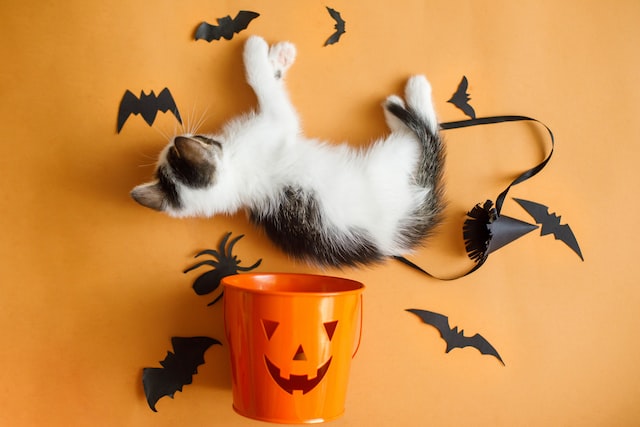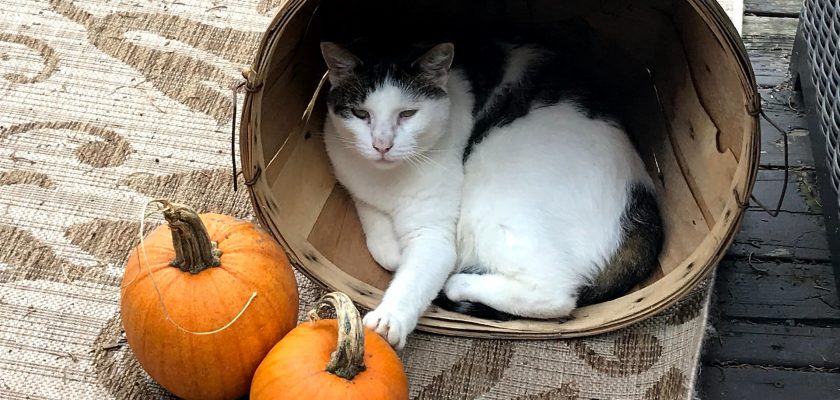When it comes to feeding your cat pumpkin, you may be wondering how much should you give your cat? Can you feed a whole pumpkin to a cat?
Can you feed a whole pumpkin to a cat?
Pumpkins are a popular fall food. They are rich in nutrients, including beta carotene, lutein, and vitamins A, C, and E. These nutrients can help prevent cell damage and promote a healthy immune system. They can also reduce the risk of developing cancer.
Pumpkin can be a great addition to a cat’s diet. It can help with digestive issues, constipation, and weight loss. However, it is best to consult your vet before giving your pet pumpkin. This is especially true if your cat has any type of GI problem.
Pumpkin is an excellent source of fiber, which may be beneficial to cats. The fiber in pumpkin helps with digestion and absorption. Fiber also contributes to a feeling of fullness. Unlike other foods, it takes a while to be digested by the body. This may lead to the feeling of being hungry again.
Some people prefer to feed their cats whole pumpkin. However, this isn’t the most convenient way to do it. If you do choose to share your pumpkin with your feline friend, make sure to keep it refrigerated. Alternatively, you can freeze it in cubes. That way, it will be an ice-cream-like treat.
Another option is to cook a whole pumpkin and then puree it. You can then add it to a kibble as a meal time appetizer. Although this is not the most convenient method, it can be a smart way to get your cat to drink more water.
Whether you’re using pumpkin for your cat’s diet or you’re giving them a treat, it’s best to limit the amount. Pumpkin can cause diarrhea in some cats, and can even cause excessive hairballs in other cats. Also, too much pumpkin can cause your cat to gain weight.
To avoid any potential complications, consult your vet before giving your cat any new type of food. While some pumpkin is safe for your cat, others contain additives, sugars, and spices. Similarly, it’s important to check the label.
Some experts believe that pumpkin has the power to lower your cat’s chances of getting cancer. Vitamins found in pumpkin are helpful in protecting your pet’s cells and reducing the risk of cancer. Additionally, it has some antioxidant properties that might help prevent cell damage from free radicals.
In addition to pumpkin, there are other treats you can give your cat that may be more helpful to his or her health. For example, pumpkin seeds are nutritious and tasty. They’re also high in fatty acids. Therefore, you might want to consider giving your cat some pumpkin seeds, raw or toasted, instead of giving them pumpkin flavored treats.
When choosing a recipe, make sure that it contains the proper amount of vitamins, minerals, and antioxidants. This will improve your pet’s overall health and skin. Choosing a high-quality cat food is also crucial. Having the right balance of nutrients in your cat’s diet will ensure that he or she remains healthy and happy.
Treating diarrhea
Pumpkin is often used as a natural treatment for diarrhea in dogs. It is a good source of fiber, and can help firm up loose stools. However, if your dog is suffering from a more serious condition, consult a vet before adding pumpkin to the diet.

Photo by Ben Hanson on Unsplash
There are many reasons why a dog may suffer from diarrhea. Some common causes include parasites, viral gastroenteritis, and fungal infections. If your pet has been suffering from diarrhea for a while, it could be an indicator of a more serious problem. A visit to a veterinarian can determine the cause of the condition and prescribe a proper course of treatment.
Pumpkin is beneficial for dogs and cats, and can be a very effective remedy for diarrhea. Adding pumpkin to your pet’s diet is easy and inexpensive. You can mix a tablespoon of canned pumpkin with a small amount of broth or water, or add a teaspoon of pumpkin to your pet’s food.
Pumpkin also contains soluble fiber, which slows down digestion and helps control stool frequency and consistency. It also absorbs water and bulks up stools, preventing dehydration. Soluble fiber can be found in all kinds of foods, but it is particularly important in pumpkin.
In addition to being a great source of soluble fiber, canned pumpkin is rich in micronutrients that are helpful to the digestive system. These nutrients include potassium and sodium. Potassium can help prevent dehydration and is important for kidney health. Sodium helps regulate the balance of fluids in the body, as well as maintain proper salt and calcium levels.
The fiber in pumpkin also promotes the growth of friendly gut bacteria. Prebiotics and probiotics promote healthy digestive tract tissue and immune health. They are known to reduce inflammation and support the gut barrier, as well as stimulate the production of short-chain fatty acids.
Because of the anti-inflammatory and antimicrobial properties of pumpkin, it is a great choice for treating diarrhea in dogs and geriatric cats. For smaller pets, it is best to begin with a dose of one to two tablespoons per day, increasing to a half-cup per day as needed. Large dogs can be given up to a cup of pumpkin a day, and geriatric dogs should be fed up to a cup of pumpkin a week.
Pumpkin is also a good source of vitamins and minerals. One cup of canned pumpkin has 505 milligrams of potassium and 12 milligrams of sodium. This is less than one percent of the daily value for sodium and potassium. Other high-potassium foods are acorn squash, bananas, and nuts.
Although pumpkin can be a very effective remedy for dog diarrhea, it is not a cure. If your dog’s diarrhea persists for longer than three days, you should consult a doctor.
If your dog is suffering from severe diarrhea, you may need to add extra sodium and potassium. This is because a diet that is too low in potassium can result in hypokalemia, which can cause cramping and weakness. Dehydration can be life-threatening in young puppies or frail seniors.
Treating food allergies
Pumpkins are an iconic food for Halloween, but some people have a hard time eating them. A pumpkin can cause allergic reactions in those who are sensitive to the proteins found within. It can also irritate the skin, and even cause hives.

Image by Unsplash+
The Teal Pumpkin Project is a campaign designed to promote awareness and inclusion of families with food allergies. It is part of an international campaign to bring attention to the prevalence of food allergies. You can help make trick-or-treating a better experience for kids with allergies by displaying a teal pumpkin on your porch.
The Teal Pumpkin Project is promoting non-food treat alternatives that can be a big hit with children. They are also encouraging parents to hand out more than just candy. These include non-food treats and toys.
Unlike a traditional pumpkin, a teal pumpkin can be used to mark the entrance to a house. This signifies that you are a safe stop for children with food allergies.
Food Allergy Research and Education (FARE) also encourages the use of teal pumpkins during this season. Their website offers a number of printable signs that explain the meaning of a teal pumpkin.
One way to find out if your house is participating in the Teal Pumpkin Project is by checking out the FARE website. This site will provide you with a map of homes that have teal pumpkins on their doorsteps. Once you have discovered which houses are participating in the program, you can add your own address to the map. For example, if you are planning on attending a trick or treating event in the future, you can sign up.
The Teal Pumpkin Project is an exciting initiative that will surely make your kids happy. Besides letting them know that you care about them and their needs, it also signals to the rest of the world that your home is safe for kids with food allergies.
The Teal Pumpkin Project is proving that the best way to keep your kids safe on Halloween is to be inclusive and aware. Kids with food allergies have a tougher time at this holiday because they are restricted to trick-or-treating, and most of the good stuff has to go in the trash.
If you are looking for an idea for a Halloween party that your kids with food allergies can enjoy, a Halloween costume party can be a great option. In addition, you can arrange a scavenger hunt. Many kids enjoy scavenger hunts, and they’re a great way to connect with friends and family.
Food allergies can be a frightening and isolating experience for children and their parents. However, the Teal Pumpkin Project can help you navigate the tricky waters of trick-or-treating. Adding a teal pumpkin to your door and inviting other food allergy families into your neighborhood will ensure that all kids get a chance to experience the fun of Halloween.
